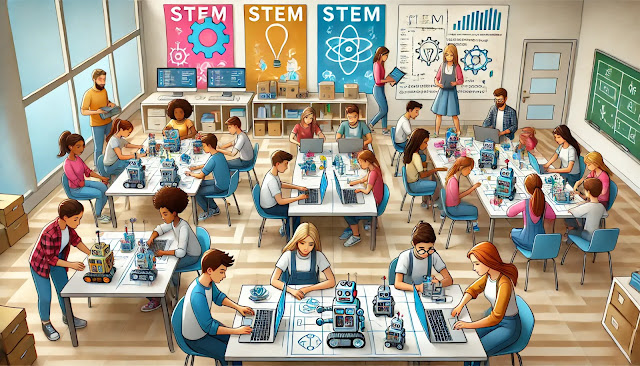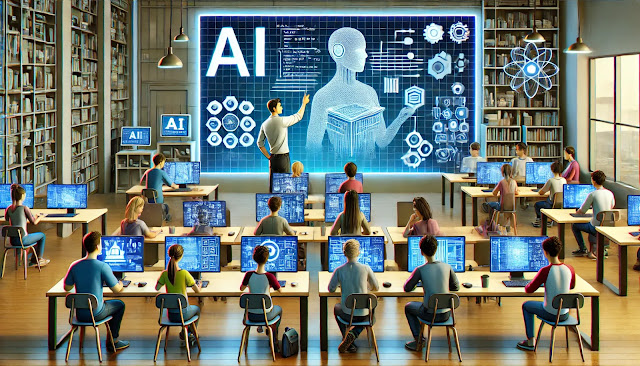Introduction
Science, Technology, Engineering, and Mathematics (STEM)
education has been the driving force behind the innovations that have shaped
the modern world. However, as technology continues to evolve at a rapid pace,
traditional STEM education must also adapt. The integration of Robotics and
Artificial Intelligence (AI) into the STEM curriculum is not just a trend but a
necessity, as these technologies are at the heart of future industries. This
article explores how the fusion of Robotics and AI in STEM education is
transforming the learning experience, preparing students for the challenges of
tomorrow.
The Role of Robotics in STEM Education
Robotics has long been a part of STEM education, but its
role has become increasingly prominent in recent years. Robots are no longer
just machines that follow pre-programmed instructions; they are becoming
intelligent systems capable of learning and adapting to their environments. By
incorporating robotics into STEM education, students can engage in hands-on
learning that encourages problem-solving, creativity, and collaboration.
One of the key benefits of using robotics in education is
the ability to teach complex concepts in a tangible way. For example, students
learning about coding, physics, or engineering can immediately apply their
knowledge by programming robots to perform tasks or solve real-world problems.
This experiential learning helps students retain information better and
understand the practical applications of theoretical concepts.
Moreover, robotics education fosters critical skills such as
computational thinking, logical reasoning, and teamwork. These are not only
essential for STEM careers but also for navigating an increasingly
technology-driven world. The rise of educational robotics platforms like LEGO
Mindstorms, VEX Robotics, and Arduino has made it easier for educators to
integrate robotics into the classroom, allowing students to explore these
systems from an early age.
The Rise of AI in STEM Education
Artificial Intelligence (AI) is another transformative force
in STEM education. While AI may seem like a highly specialized field, it has
become more accessible to students thanks to advancements in machine learning
tools and platforms. By learning AI concepts, students are not just preparing
for careers in data science or software engineering; they are gaining skills
that will be relevant across a wide range of industries, from healthcare to
finance.
AI can also enhance the learning process itself. Adaptive
learning platforms, powered by AI, personalize education by analyzing a
student’s performance and adjusting the curriculum in real-time. These systems
can identify a student’s strengths and weaknesses, offering targeted support to
ensure mastery of key concepts. In this way, AI serves as both a subject of
study and a tool for improving educational outcomes.
In STEM education, AI can be used to create more
sophisticated robots, allowing students to explore fields like computer vision,
natural language processing, and autonomous systems. By working on AI-driven
projects, students can develop a deeper understanding of how machines can learn
from data, recognize patterns, and make decisions without human intervention.
Benefits of Integrating Robotics and AI in STEM
Integrating robotics and AI into STEM education offers
numerous advantages:
- Hands-on
Learning: Robotics and AI provide interactive, project-based learning
opportunities that make abstract concepts more concrete. Students can see
the direct results of their work, making learning more engaging and
meaningful.
- Real-world
Application: Students gain insights into how technology is applied in
industries like manufacturing, healthcare, and agriculture. For instance,
robots powered by AI are used in automation, surgery, and precision
farming. By working on similar projects, students develop skills that are
highly sought after in the job market.
- Problem-solving
and Critical Thinking: Robotics and AI require students to think
critically and solve complex problems. Whether it’s debugging code or
designing a machine learning algorithm, students must engage in logical
reasoning and troubleshooting.
- Collaboration
and Teamwork: Many robotics and AI projects require collaboration,
helping students develop interpersonal skills. In today’s interconnected
world, teamwork is crucial, and robotics competitions or group AI projects
encourage this.
- Preparing
for the Future: As AI and robotics become more prevalent, jobs in
these fields are expected to grow exponentially. By introducing students
to these technologies early on, educators are preparing them for the jobs
of the future, which will require proficiency in automation, machine
learning, and robotics engineering.
Challenges in Integrating Robotics and AI in STEM
Despite the benefits, integrating robotics and AI into STEM
education comes with challenges. One major hurdle is the cost of equipment and
technology. While platforms like Raspberry Pi and Arduino offer affordable
options, schools still need funding to create fully equipped robotics labs.
Additionally, teachers need training to effectively deliver AI and robotics
education. Many educators may not have the background in computer science or
engineering to teach these subjects, which can limit the accessibility of such
programs.
Moreover, the rapid pace of technological advancement means
that STEM curricula need constant updates to stay relevant. What students learn
today may become outdated in just a few years. Therefore, schools must adopt a
flexible approach that emphasizes lifelong learning and adaptability, rather
than focusing solely on specific tools or technologies.
The Future Outlook
The future of STEM education lies in the continued
integration of robotics and AI. These fields are expected to revolutionize
industries, making it crucial for students to develop proficiency in them.
Governments and educational institutions are recognizing this and are working
to incorporate robotics and AI into national curriculums. Initiatives like the
“Hour of Code” and “AI for K-12” are helping bridge the gap, making these
technologies more accessible to students worldwide.
In the coming years, we can expect to see more AI-powered
educational tools that adapt to individual learning styles, making STEM
education more personalized and effective. Additionally, robotics competitions
and AI hackathons will likely become more popular, encouraging students to
pursue careers in these cutting-edge fields.
As we look towards the future, the integration of robotics
and AI in STEM education will play a pivotal role in shaping the next
generation of innovators and problem solvers. By equipping students with the
knowledge and skills they need to navigate an increasingly technological world,
we are not only preparing them for successful careers but also empowering them
to drive future innovations that will benefit society as a whole. The future of
STEM is bright, and with robotics and AI at its core, the possibilities are
limitless.







0 Comments